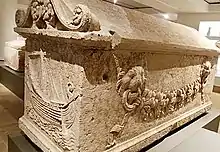Ship Sarcophagus
The Ship Sarcophagus, also known as the Sarcophagus au Navire, is a Roman era sarcophagus found by Georges Contenau in 1913 in Magharet Abloun, a necropolis containing the remains of Phoenician kings and notables in the south of Sidon in modern-day Lebanon. The sarcophagus has been dated to the 2nd century CE.[1][2]

National Museum of Beirut – Ship Sarcophagus 3
It is considered the most important of all the sarcophagi discovered by Contenau in Sidon.[3]
The relief at the head of the sarcophagus represents an ancient ship.[3]
Bibliography
- Editio princeps: Georges Contenau. “Mission archéologique à Sidon (1914). In: Syria. Volume 1, 1920. pp. 16–55. DOI: https://doi.org/10.3406/syria.1920.2837
References
Wikimedia Commons has media related to Ship sarcophagus.
- Stillwell, Richard, ed. (1976). The Princeton Encyclopedia of Classical Sites. Princeton University Press. p. SIDON (Saida) Lebanon entry.
- Herm, Gerhard (1975). The Phoenicians: The Purple Empire of the Ancient World. Morrow. p. 127. ISBN 978-0-688-02908-1.
- "Sidon." In The Oxford Encyclopedia of Archaeology in the Near East. Ed. Eric M. Meyers, Issam Ali Khalifeh. Oxford Biblical Studies Online: "In 1913 Georges Contenau, director of the Department of Oriental Antiquities of the Louvre Museum, uncovered a series of Roman sarcophagi at Magharat Ablun, of which the Sarcophage au Navire is the most important. On it a sculptured relief of a Roman ship is depicted."
This article is issued from Wikipedia. The text is licensed under Creative Commons - Attribution - Sharealike. Additional terms may apply for the media files.